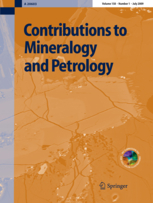 | |
| Discipline | Earth sciences |
|---|---|
| Language | English |
| Edited by | T.L. Grove, O. Müntener |
| Publication details | |
| History | 1947-present |
| Publisher | |
| Frequency | Monthly |
| hybrid | |
| 3.23 (2018) | |
| Standard abbreviations | |
| ISO 4 | Contrib. Mineral. Petrol. |
| Indexing | |
| CODEN | CMPEAP |
| ISSN | 0010-7999 (print) 1432-0967 (web) |
| LCCN | sf98085520 |
| OCLC no. | 39974874 |
| Links | |
Contributions to Mineralogy and Petrology is a peer-reviewed scientific journal published by Springer Science+Business Media since 1947. The journal is a hybrid open-access journal. The journal covers the fields of igneous and metamorphic petrology, geochemistry, and mineralogy.